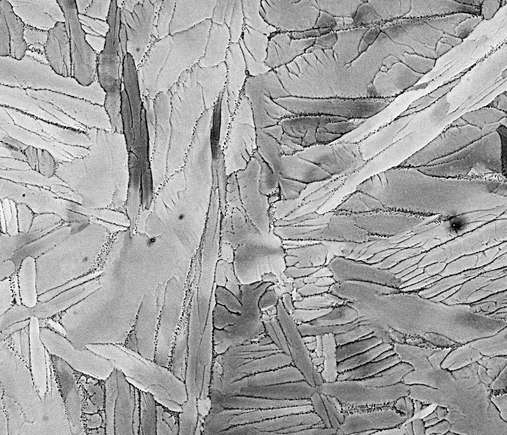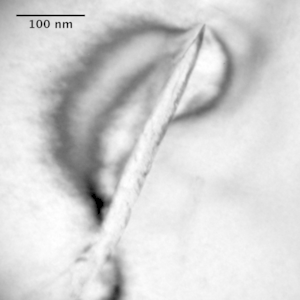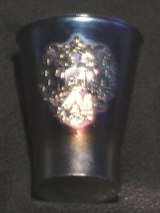Zirconium alloy
Zirconium alloys are solid solutions of zirconium or other metals, a common subgroup having the trade mark Zircaloy. Zirconium has very low absorption cross-section of thermal neutrons, high hardness, ductility and corrosion resistance. One of the main uses of zirconium alloys is in nuclear technology, as cladding of fuel rods in nuclear reactors, especially water reactors. A typical composition of nuclear-grade zirconium alloys is more than 95 weight percent[1] zirconium and less than 2% of tin, niobium, iron, chromium, nickel and other metals, which are added to improve mechanical properties and corrosion resistance.[2]
The water cooling of reactor zirconium alloys elevates requirement for their resistance to oxidation-related nodular corrosion. Furthermore, oxidative reaction of zirconium with water releases hydrogen gas, which partly diffuses into the alloy and forms zirconium hydrides[3]. The hydrides are less dense and are weaker mechanically than the alloy; their formation results in blistering and cracking of the cladding – a phenomenon known as hydrogen embrittlement.[4][5]
Production and properties
Commercial non-nuclear grade zirconium typically contains 1–5% of hafnium, whose neutron absorption cross-section is 600 times that of zirconium. Hafnium must therefore be almost entirely removed (reduced to < 0.02% of the alloy) for reactor applications.[2][6]
Nuclear-grade zirconium alloys contain more than 95% Zr, and therefore most of their properties are similar to those of pure zirconium. The absorption cross section for thermal neutrons is 0.18 barn for zirconium, which is much lower than that for such common metals as iron (2.4 barn) and nickel (4.5 barn).[6] The composition and the main applications of common reactor-grade alloys are summarized below. These alloys contain less than 0.3% of iron and chromium and 0.1–0.14% oxygen.[7]
| Alloy | Sn, % | Nb, % | Vendor (country) | Component | Reactor type |
|---|---|---|---|---|---|
| Zircaloy 2 | 1.2–1.7 | – | All vendors | Cladding, structural components | BWR, CANDU |
| Zircaloy 4 | 1.2–1.7 | – | All vendors | Cladding, structural components | BWR, PWR, CANDU |
| ZIRLO | 0.7–1 | 1 | Westinghouse | Cladding | BWR, PWR |
| Zr Sponge | – | – | Japan and Russia | Cladding | BWR |
| ZrSn | 0.25 | – | Westinghouse | Cladding | BWR |
| Zr2.5Nb | – | 2.4–2.8 | Fabrica de Aleaciones Especiales(FAE)(Argentina) | Pressure tube | CANDU |
| E110 | – | 0.9–1.1 | Russia | Cladding | VVER |
| E125 | – | 2.5 | Russia | Pressure tube | RBMK |
| E635 | 0.8–1.3 | 0.8–1 | Russia | Structural components | VVER |
| M5 | – | 0.8–1.2 | Areva | Cladding, structural components | PWR |
*ZIRLO stands for zirconium low oxidation.
Microstructure

At temperatures below 1100 K, zirconium alloys belong to the hexagonal crystal family (HCP). Its microstructure, revealed by chemical attack, shows needle-like grains typical of a Widmanstätten pattern. Upon annealing below the phase transition temperature (α-Zr to β-Zr) the grains are equiaxed with sizes varying from 3 to 5 μm[8][9].
Development
Zircaloy 1 was developed as a replacement for existing tube bundles in submarine reactors in the 1950s, owing to a combination of strength, low neutron cross section and corrosion resistance[10]. Zircaloy-2 was inadvertently developed, by melting Zircaloy-1 in a crucible previously used for stainless steel[10]. Newer alloys are Ni-free, including Zircaloy-4, ZIRLO and M5.
Oxidation of zirconium alloy
Zirconium alloys readily react with oxygen, forming a nanometer-thin passivation layer[11]. The corrosion resistance of the alloys may degrade significantly when some impurities (e.g. more than 40 ppm of carbon or more than 300 ppm of nitrogen) are present.[12] Corrosion resistance of zirconium alloys is enhanced by intentional development of thicker passivation layer of black lustrous zirconium oxide. Nitride coatings might also be used.
Whereas there is no consensus on whether zirconium and zirconium alloy have the same oxidation rate, Zircaloys 2 and 4 do behave very similarly in this respect. Oxidation occurs at the same rate in air or in water and proceeds in ambient condition or in high vacuum. A sub-micrometer thin layer of zirconium dioxide is rapidly formed in the surface and stops the further diffusion of oxygen to the bulk and the subsequent oxidation. The dependence of oxidation rate R on temperature and pressure can be expressed as[13]
- R = 13.9·P1/6·exp(−1.47/kBT)
The oxidation rate R is here expressed in gram/(cm2·second); P is the pressure in atmosphere, that is the factor P1/6 = 1 at ambient pressure; the activation energy is 1.47 eV; kB is the Boltzmann constant (8.617×10−5 eV/K) and T is the absolute temperature in kelvins.
Thus the oxidation rate R is 10−20 g per 1 m2 area per second at 0 °C, 6×10−8 g m−2 s−1 at 300 °C, 5.4 mg m−2 s−1 at 700 °C and 300 mg m−2 s−1 at 1000 °C. Whereas there is no clear threshold of oxidation, it becomes noticeable at macroscopic scales at temperatures of several hundred °C.
Oxidation of zirconium by steam
One disadvantage of metallic zirconium is that in the case of a loss-of-coolant accident in a nuclear reactor, zirconium cladding rapidly reacts with water steam at high temperature. Oxidation of zirconium by water is accompanied by release of hydrogen gas. This oxidation is accelerated at high temperatures, e.g. inside a reactor core if the fuel assemblies are no longer completely covered by liquid water and insufficiently cooled.[14] Metallic zirconium is then oxidized by the protons of water to form hydrogen gas according to the following redox reaction:
- Zr + 2 H2O → ZrO2 + 2 H2
Zirconium cladding in the presence of D2O deuterium oxide frequently used as the moderator and coolant in next gen pressurized heavy water reactors that CANDU designed nuclear reactors use would express the same oxidation on exposure to deuterium oxide steam as follows:
- Zr + 2 D2O → ZrO2 + 2 D2
This exothermic reaction, although only occurring at high temperature, is similar to that of alkali metals (such as sodium or potassium) with water. It also closely resembles the anaerobic oxidation of iron by water (reaction used at high temperature by Antoine Lavoisier to produce hydrogen for his experiments).
This reaction was responsible for a small hydrogen explosion accident first observed inside the reactor building of Three Mile Island Nuclear Generating Station in 1979 that did not damage the containment building. This same reaction occurred in boiling water reactors 1, 2 and 3 of the Fukushima Daiichi Nuclear Power Plant (Japan) after reactor cooling was interrupted by related earthquake and tsunami events during the disaster of March 11, 2011, leading to the Fukushima Daiichi nuclear disaster. Hydrogen gas was vented into the reactor maintenance halls and the resulting explosive mixture of hydrogen with air oxygen detonated. The explosions severely damaged external buildings and at least one containment building.[15] The reaction also occurred during the Chernobyl Accident, when the steam from the reactor began to escape.[16] Many water cooled reactor containment buildings have catalyst-based recombinator units installed to rapidly convert hydrogen and oxygen into water at room temperature before the explosive limit is reached.
Formation of hydrides and hydrogen embrittlement

Also, 5–20 % of hydrogen diffuses into the zirconium alloy cladding forming zirconium hydrides.[17] The hydrogen production process also mechanically weakens the rods cladding because the hydrides have lower ductility and density than zirconium or its alloys, and thus blisters and cracks form upon hydrogen accumulation.[4] This process is also known as hydrogen embrittlement. It has been reported that the concentration of hydrogen within hydrides is also dependent on the nucleation site of the precipitates.[18][19]
In case of loss-of-coolant accident (LOCA) in a damaged nuclear reactor, hydrogen embrittlement accelerates the degradation of the zirconium alloy cladding of the fuel rods exposed to high temperature steam.[20]
Applications

Zirconium alloys are corrosion resistant and biocompatible, and therefore can be used for body implants.[6] In one particular application, a Zr-2.5Nb alloy is formed into a knee or hip implant and then oxidized to produce a hard ceramic surface for use in bearing against a polyethylene component. This oxidized zirconium alloy material provides the beneficial surface properties of a ceramic (reduced friction and increased abrasion resistance), while retaining the beneficial bulk properties of the underlying metal (manufacturability, fracture toughness, and ductility), providing a good solution for these medical implant applications.
Reduction of zirconium demand in Russia due to nuclear demilitarization after the end of the cold war resulted in the exotic production of household zirconium items such as the vodka shot glass shown in the picture.
References
- Alloys' constituents are usually measured by mass.
- Mary Eagleson (1994). Concise encyclopedia chemistry. Walter de Gruyter. pp. 1199–. ISBN 978-3-11-011451-5. Retrieved 18 March 2011.
- Carpenter, G.J.C.; Watters, J.F. (1978). "An in-situ study of the dissolution of γ-zirconium hydride in zirconium". Journal of Nuclear Materials. 73 (2): 190–197. Bibcode:1978JNuM...73..190C. doi:10.1016/0022-3115(78)90559-7.
- Delayed hydride cracking in zirconium alloys in pressure tube nuclear reactors, Final report of a coordinated research project 1998–2002, IAEA, October 2004
- Nuclear Fuel Fabrication Archived July 26, 2011, at the Wayback Machine, Fuel Fabrication Archived July 26, 2011, at the Wayback Machine World Nuclear Association, March 2010
- George S. Brady; Henry R. Clauser; John A. Vaccari (24 July 2002). Materials Handbook (15th ed.). McGraw-Hill Professional. pp. 1063–. ISBN 978-0-07-136076-0. Retrieved 18 March 2011.
- Peter Rudling; Alfred Strasser; Friedrich Garzarolli (2007). Welding of Zirconium Alloys (PDF). Sweden: Advanced Nuclear Technology International.
- Tunes, M. A.; Harrison, R. W.; Greaves, G.; Hinks, J. A.; Donnelly, S. E. (September 2017). "Effect of He implantation on the microstructure of zircaloy-4 studied using in situ TEM" (PDF). Journal of Nuclear Materials. Elsevier. 493: 230–238. Bibcode:2017JNuM..493..230T. doi:10.1016/j.jnucmat.2017.06.012.
- Pshenichnikov, Anton; Stuckert, Juri; Walter, Mario (2015-03-01). "Microstructure and mechanical properties of Zircaloy-4 cladding hydrogenated at temperatures typical for loss-of-coolant accident (LOCA) conditions". Nuclear Engineering and Design. SI:NENE 2013. 283: 33–39. doi:10.1016/j.nucengdes.2014.06.022.
- "Light Water Reactor Sustainability Program Advanced LWR Nuclear Fuel Cladding System Development: Technical Program Plan" (PDF).
- Atom-Probe analysis of Zircaloy (PDF)
- Corrosion of Zircaloy Spent Fuel Cladding in a Repository National Research Council, July 1989
- Rion A. Causey, Don F. Cowgill, and Bob H. Nilson (2005) Review of the Oxidation Rate of Zirconium Alloys, Engineered Materials Department and Nanoscale Science and Technology Department Sandia National Laboratories
- Luc Gillon (1979). Le nucléaire en question, Gembloux Duculot, French edition, 240 pp.
- Japanese engineers work to contain nuclear reactor damage, Los Angeles Times, March 14, 2011
- Chernobyl Accident Appendix 1: Sequence of Events, World Nuclear Association, November 2009
- DOE-HDBK-1017/2-93, January 1993, DOE Fundamentals Handbook, Material Science, Volume 2 of 2, U.S. Department of Energy, January 2003, pp. 12, 24.
- Tunes, Matheus A.; Silva, Chinthaka M.; Edmondson, Philip D. (January 2019). "Site specific dependencies of hydrogen concentrations in zirconium hydrides". Scripta Materialia. 158: 136–140. doi:10.1016/j.scriptamat.2018.08.044. ISSN 1359-6462. OSTI 1481703.
- Motta, Arthur T.; Capolungo, Laurent; Chen, Long-Qing; Cinbiz, Mahmut Nedim; Daymond, Mark R.; Koss, Donald A.; Lacroix, Evrard; Pastore, Giovanni; Simon, Pierre-Clément A.; Tonks, Michael R.; Wirth, Brian D.; Zikry, Mohammed A. (2019). "Hydrogen in zirconium alloys: A review". Journal of Nuclear Materials. 518: 440–460. doi:10.1016/j.jnucmat.2019.02.042. ISSN 0022-3115.
- Nuclear Fuel Behaviour in Loss-of-coolant Accident (LOCA) Conditions. State-of-the-art Report. OECD 2009, NEA No. 6846. https://www.oecd-nea.org/nsd/reports/2009/nea6846_LOCA.pdf
External links
| Look up zircaloy or zircoloid in Wiktionary, the free dictionary. |
- "Zircaloy – an overview – ScienceDirect Topics". www.sciencedirect.com. Retrieved 9 May 2020.
- Google books search results for the dedicated conference named "Zirconium in the nuclear industry"
- Construction of the Fukushima nuclear power plants